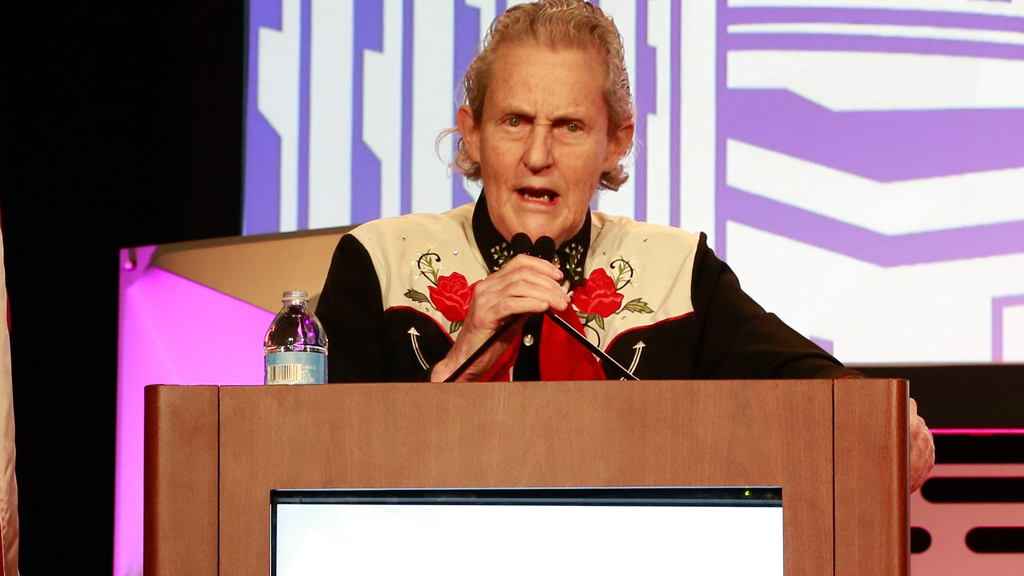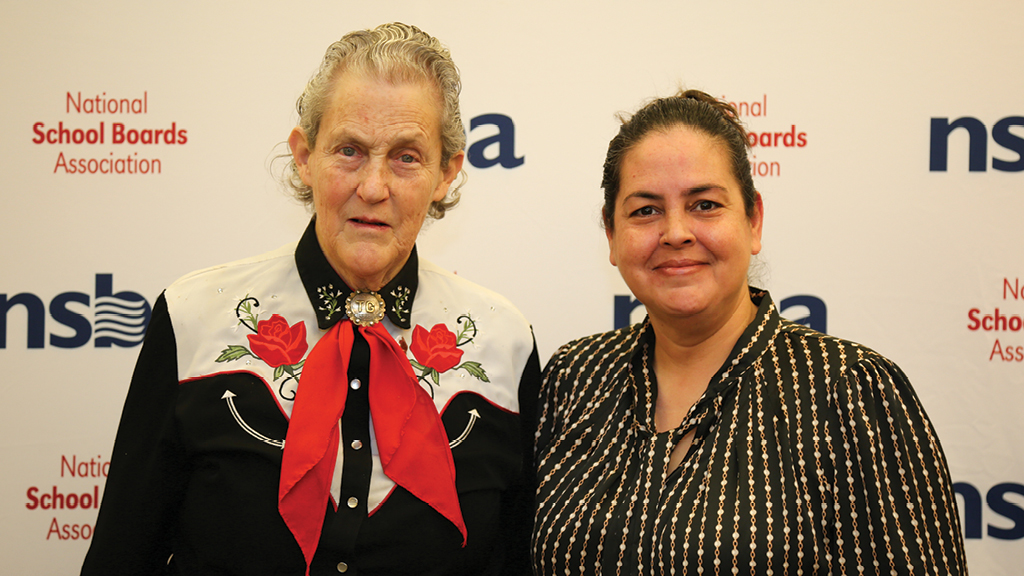
KEYNOTE SPEAKER TEMPLE GRANDIN AT NSBA'S 2024 ADVOCACY INSTITUTE.
Flashing LED lights in classrooms can torment students with sensory issues, including those with autism. When asked how to check for flashing lights, autism spokesperson and animal behavior scientist Temple Grandin pulled her cellphone out of her pocket.
“Sometimes the way to fix something is right there and you don’t know it,” she said. “Set the phone for regular slow-motion video. Take pictures of the room. You’ll find them; they’ll flicker.”
Grandin was a keynote speaker at NSBA’s Advocacy Institute in January in Washington, D.C. Her answer perfectly illustrated the different approaches to problem solving that she spoke about to the audience, and the importance of including and valuing diverse ways of thinking.
Grandin is a distinguished professor of animal science at Colorado State University. Her designs of livestock handling facilities are used by many companies around the world. She also has been instrumental in implementing animal welfare auditing programs that are used by McDonald’s, Wendy’s, Whole Foods, and other corporations. Her books include Thinking in Pictures, The Autistic Brain, and Visual Thinking.
The following are excerpts from Grandin’s keynote speech:
The first thing that you have to understand is there’s different ways that people think, and there’s different approaches to problem-solving. Now, I was a severely autistic kid. I had no speech until age 4. A lot of people thought I’d go nowhere. But I’ll tell you right now that I designed the front end of every Cargill beef plant in North America. I think that’s doing pretty good for somebody they thought was mentally [disabled]. We need the skills of people who think differently. Now, I’m a total visual thinker and I didn’t know that other people thought in words until I was in my 30s. It was a big shock to find out that some people think differently. There’s evidence that there’s two kinds of visual thinking. There’s the picture visual thinking and there’s the pattern and math type visual thinking. Now, being a visual thinker helped me understand animals, because animals live in a sensory-based world. They don’t live in a word-based world.
How do we look at risk and how do we solve problems? The Fukushima nuclear power plant in Japan burned up because the mathematicians didn’t see that they should have waterproof doors to protect the electric emergency cooling pump that was in the basement. The pump won’t work underwater. Another example of seeing risk. A businessman on an airplane takes a little plastic cup of water while the plane is flying and puts it on his open laptop. Really? One bump and it’s bye-bye laptop. There’s no way I would do that. A person who thinks in pictures sees risk. I’m seeing that plastic cup right now on that laptop. A mathematician will calculate what is the probability this plane will hit a bump and they spill the cup of water, and the verbal thinkers discuss risk.
There are three basic kinds of thinking. There is also going to be mixtures of thinking. Now the first type is me, the object visualizer who is very good with mechanical things, very good with art. But we can’t do algebra. I’m very worried that my kind of visual thinker is going to be screened out. If you’d like the lights to stay on in this hotel and maybe the rest of Washington. you’re going to need skilled tradespeople. You’re going to need a lot of different people who can visualize how things work. Now, if you’re going to do orbital mechanics, yes, you need that higher math. About 20% of the very high-end skilled tradespeople I worked with would be special education kids today. They are not getting replaced, and we need them badly.
There are mathematicians. Computer programming, engineering, chemistry, physics, music, and math go together. Then you have the verbal thinkers -—writers, sales, finance, psychologists, lawyers, and teachers. These people primarily think in words, which I don’t. Everything that I think about is a picture. That’s how I store my memories. And one of the problems I have with algebra is there’s nothing for me to store. I can’t remember it. There’s no pictures. Now I’m not suggesting that they get out of all math. How about taking geometry? How about business math? How about household math?
Now this is some of the research that shows that different kinds of thinking exist, especially in two kinds of visualizers. The object visualizer like me, who thinks in photographs and the visual spatial, who thinks in patterns, patterns, not photographs. And a lot of people are mixtures of the different kinds of thinking. Turns out I have [a] huge graphic circuit in my head. Really big visual thinking circuit. Now let’s look at how different thinkers take in information. The object visualizer wants to look at pictures or look at the actual machine. The verbal thinker wants to read about it. The mathematician tends to look at both. There was a study of high school students. They had art students, science students, and humanities and literature students do an art project to create a planet. The art students come up with crystals and polar bears and all kinds of stuff. The science students draw a circle and describe the gravity and the atmosphere. The humanities students made some splotches. The verbal thinkers did no planning. The other teams did the planning. You see verbal thinking is very top down. We hear about all these policies. How do you implement the policy? They overgeneralize.
How do we teach autistic kids? Well, I can give you some specific things on, especially when they get out on the job. Checklists. Pilots need a checklist for tasks involving sequence. Give them a pilot checklist. You talk about making the classroom more autism-friendly. I’ll tell you what to do. Use directions and checklists. Get rid of the LED lights that flicker and get rid of bullying. Those are three specific things you can do.
The early inventors were all object visualizers designing mechanical devices. A blacksmith made the grain harvester; bicycle mechanics made the first airplane. We’ve got a problem. There’s stuff we don’t make anymore. And it goes back to taking the shop classes out of schools. Over half of all large industrial 3D printers come from Europe. There’s a state-of-the-art electronic chip-making machine made in Holland. It costs $300 million and fits in 13 shipping containers. It makes the very, very smallest, finest electronic computer chips based on mathematics from the U.S. You want a poultry processing plant? You’re going to have to import all that equipment from Holland. We’re not making this stuff and we’re taking out the shop classes, taking out the hands-on classes. Visual thinking is not a lesser form of intelligence. It’s a different form of intelligence. And the thing is, you need to have all the different kinds of minds.
Then we paid the price for taking out the hands-on classes. When I was a little kid, I loved art, sewing, and woodworking. I had a toy sewing machine that actually sewed. It was my favorite thing to play musical instruments. I was horrible at it. But another kid’s going to take off with musical instruments, woodworking, welding, or theater.
I’m following AI really closely and watching which jobs it’s going to knock out. And I can tell you right now, if it’s hands-on, the job is safe. Live music and live theater are safe.
I’ve never passed an algebra class. I majored in psychology to dodge the algebra classes. I’m seeing people who want to be a veterinary technician spinning their wheels off taking their second or third algebra class at a community college. You don’t need algebra to be a veterinary technician. And what little tiny amount of it you might need for drug dosing can be memorized. But I think why they’re pushing the algebra, just like this lady I ran into earlier who didn’t know visual thinking existed. You see, it’s a different way of thinking. Algebra is needed for some things, but we have to start thinking about what requirements are really needed for different types of students.
Let’s look at who builds a large food plant. The object visualizers. People in the shop who are high school educated. They are designing complicated equipment like packaging machinery. Also, a drafting technician with a one-semester class in drafting is laying out entire factories. I’ve worked with them. The problem is people I’ve worked with are retiring. Another big mistake the plants made was shutting down in-house engineering. Gigantic mistake. And then your math thinkers, yep, we need you. We have to make sure the roof doesn’t collapse. This is where you need the different minds. And we have a big shortage of things like electricians. When I wrote the book Visual Thinking, I would do the disorganized, rough drafts, and my co-writer would straighten them out. So that’s different minds working together. Architects make a building look nice. Engineers make sure it’s safe. You need to have both. About 20% of the people I worked with are either autistic, dyslexic, or ADHD, and they own metal companies, have multiple patents, and are designing and building complicated equipment. Most of them couldn’t do abstract math.
Steve Jobs was probably on the spectrum; he was bullied in school. Albert Einstein had no speech until age 3. He’d land in an autism class today. Thomas Edison was probably on the spectrum, but he learned how to work. He was selling papers at a very young age.
A Nobel Prize winner was 50% more likely to have an arts and crafts hobby compared to other scientists. That’s another reason for keeping all the hands-on classes [in] the schools. Tips for working with minds that are different. Let’s avoid the rapid multitasking jobs and go to tasks that involve a sequence. Let’s say I have to clean the McDonald’s ice cream machine. There’s a checklist for taking it apart, a checklist for cleaning, and a checklist for reassembly. Long strings of verbal instruction do not work. Vagueness doesn’t work.
What’s the ultimate goal of education? Where is a student 10 years after high school graduation? I was designing some of my very first big projects. That’s what I was doing. And the way I sold my work was showing up [with] my portfolio. I sold my work and I drew this drawing in 1978. And I remember looking at this drawing and I’m going, maybe I’m not so stupid after all. ‘Cause the thing that motivated me is I wanted to prove I wasn’t stupid.

TEMPLE GRANDIN WITH NSBA BOARD MEMBER MILDRED LEFEBVRE.
NSBA PHOTOS

Share this content